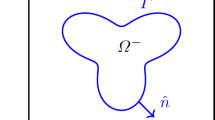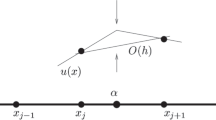Abstract
We propose a high-order FDTD scheme based on the correction function method (CFM) to treat interfaces with complex geometry without significantly increasing the complexity of the numerical approach for constant coefficients. Correction functions are modeled by a system of PDEs based on Maxwell’s equations with interface conditions. To be able to compute approximations of correction functions, a functional that is a square measure of the error associated with the correction functions’ system of PDEs is minimized in a divergence-free discrete functional space. Afterward, approximations of correction functions are used to correct a FDTD scheme in the vicinity of an interface where it is needed. We perform a perturbation analysis on the correction functions’ system of PDEs. The discrete divergence constraint and the consistency of resulting schemes are studied. Numerical experiments are performed for problems with different geometries of the interface. A second-order convergence is obtained for a second-order FDTD scheme corrected using the CFM. High-order convergence is obtained with a corrected fourth-order FDTD scheme. The discontinuities within solutions are accurately captured without spurious oscillations.
















Similar content being viewed by others
References
Abraham, D.S., Giannacopoulos, D.D.: A parallel implementation of the correction function method for Poisson’s equation with immersed surface charges. IEEE Trans. Magn. 53, 1–4 (2017)
Abraham, D.S., Marques, A.N., Nave, J.C.: A correction function method for the wave equation with interface jump conditions. J. Comput. Phys. 353, 281–299 (2018)
Assous, F., Ciarlet, P., Segré, J.: Numerical solution to time-dependent Maxwell equations in two-dimensional singular domains: the singular complement method. J. Comput. Phys. 161, 218–249 (2000)
Assous, F., Degond, P., Heintze, E., Raviart, P.A., Segre, J.: On a finite-element method for solving the three-dimensional Maxwell equations. J. Comput. Phys. 109, 222–237 (1993)
Brenner, S.C., Li, F., Sung, L.Y.: A locally divergence-free interior penalty method for two-dimensional curl–curl problems. SIAM J. Numer. Anal. 46(3), 1190–1211 (2008)
Carpenter, M.H., Gottlieb, D., Abarbanel, S., Don, W.S.: The theoretical accuracy of Runge-Kutta time discretizations for the initial boundary value problem: a study of the boundary error. SIAM J. Sci. Comput. 16(6), 1241–1252 (1995)
Cockburn, B., Li, F., Shu, C.W.: Locally divergence-free discontinuous Galerkin methods for the Maxwell equations. J. Comput. Phys. 194(2), 588–610 (2004)
Costabel, M., Dauge, M., Nicaise, S.: Singularities of Maxwell interface problems. M2AN 33, 627–649 (1999)
Deng, S.: On the immersed interface method for solving time-domain Maxwell’s equations in materials with curved dielectric interfaces. Comput. Phys. Commun. 179(11), 791–800 (2008)
Ditkowski, A., Dridi, K., Hesthaven, J.S.: Convergent cartesian grid methods for Maxwell equations in complex geometries. J. Comput. Phys. 170, 39–80 (2001)
Dridi, K., Hesthaven, J.S., Ditkowski, A.: Staircase-free finite-difference time-domain formulation for general materials in complex geometries. IEEE Trans. Antennas Propag. 49(5), 749–756 (2001)
Fedkiw, R.P., Aslam, T., Merriman, B., Osher, S.: A non-oscillatory Eulerian approach to interfaces in multimaterial flows (the ghost fluid method). J. Comput. Phys. 152, 457–492 (1999)
Hesthaven, J.S.: High-order accurate methods in time-domain computational electromagnetics: a review. Adv. Imaging Electron Phys. 127, 59–123 (2003)
Jiang, B., Wu, J., Povinelli, L.: The origin of spurious solutions in computational electromagnetics. J. Comput. Phys. 125(1), 104–123 (1996)
Jin, J.M.: The Finite Element Method in Electromagnetics. Wiley, New York (2014)
LeVeque, R.J., Li, Z.: The immersed interface method for elliptic equations with discontinuous coefficients and singular sources. SIAM J. Numer. Anal. 31(4), 1019–1044 (1994)
Marques, A.N., Nave, J.C., Rosales, R.R.: Imposing jump conditions on nonconforming interfaces for the correction function method: a least squares approach. J. Comput. Phys. 397, 108869 (2019)
Marques, A.N., Nave, J.C., Rosales, R.R.: A correction function method for Poisson problems with interface jump conditions. J. Comput. Phys. 230, 7567–7597 (2011)
Marques, A.N., Nave, J.C., Rosales, R.R.: High order solution of Poisson problems with piecewise constant coefficients and interface jumps. J. Comput. Phys. 335, 497–515 (2017)
Munz, C.D., Omnes, P., Schneider, R., Sonnendrücker, E., Voß, U.: Divergence correction techniques for Maxwell solvers based on a hyperbolic model. J. Comput. Phys. 161, 484–511 (2000)
Nguyen, D.D., Zhao, S.: A new high order dispersive FDTD method for Drude material with complex interfaces. J. Comput. Appl. Math. 289, 1–14 (2015)
Tóth, G.: The \(\nabla \cdot {\mathbf{B}} = 0\) constraint in shock-capturing magnetohydrodynamics codes. J. Comput. Phys. 161, 605–652 (2000)
Yee, K.S.: Numerical solution of initial boundary value problems involving Maxwell’s equations in isotropic media. IEEE Trans. Antennas Propag. 14(3), 302–307 (1966)
Zhao, S.: A fourth order finite difference method for waveguides with curved perfectly conducting boundaries. Comput. Methods Appl. Mech. Eng. 199, 2655–2662 (2010)
Zhao, S., Wei, G.W.: High-order FDTD methods via derivative matching for Maxwell’s equations with material interfaces. J. Comput. Phys. 200, 60–103 (2004)
Acknowledgements
The authors are grateful to Professor Charles Audet for interesting and helpful conversations. The research of Professor Jean-Christophe Nave was partially supported by the NSERC Discovery Program.
Author information
Authors and Affiliations
Corresponding author
Additional information
Publisher's Note
Springer Nature remains neutral with regard to jurisdictional claims in published maps and institutional affiliations.
Rights and permissions
About this article
Cite this article
Law, YM., Marques, A.N. & Nave, JC. Treatment of Complex Interfaces for Maxwell’s Equations with Continuous Coefficients Using the Correction Function Method. J Sci Comput 82, 56 (2020). https://doi.org/10.1007/s10915-020-01148-6
Received:
Revised:
Accepted:
Published:
DOI: https://doi.org/10.1007/s10915-020-01148-6
Keywords
- Interface jump conditions
- Maxwell’s equations
- Correction function method
- Finite-difference time-domain
- High order




